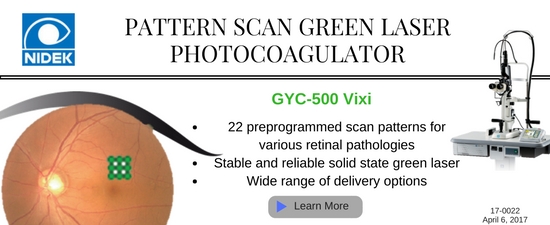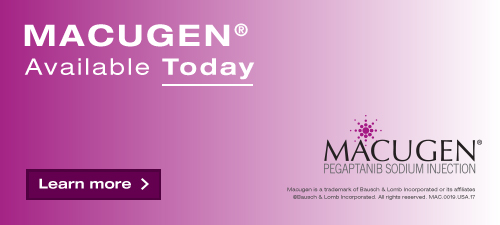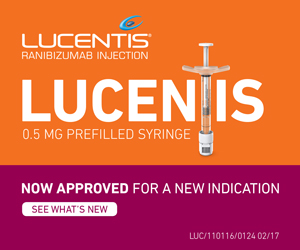Six-month VA & Retinal Thickness Outcomes in ME Secondary to CRVO or HRVO: SCORE2 Study Report 4
Analysis of a Clinical Trial Comparing Aflibercept, Bevacizumab & Ranibizumab for DR Change
Teleophthalmology Image-based Navigated Retinal Laser Therapy for DME
Angiopoietin-like Protein 8 & VEGF in PDR
Sensitivity & Specificity of OCTA for Detecting Choroidal Neovascularization
HDL Cholesterol-associated Mechanisms in AMD Etiology Adalimumab for Noninfectious Intermediate Uveitis, Posterior Uveitis and Panuveitis in the VISUAL-1 and -2 Trials Risk of Ocular Hypertension in Adults with Noninfectious Uveitis Long-term Follow-up of Fellow Eyes With Lamellar Macular Hole Correlation of Radial Peripapillary Capillary Density Network With RNFL Thickness Evolution of Outer Retinal Tubulation, a Neurodegeneration and Gliosis in Macular Diseases
|
|||||||||||||||||||||||||||||||||||||||
Patient Recruitment Completed in Abicipar Pegol nAMD Phase III Studies Molecular Partners, a clinical-stage biopharmaceutical company developing a new class of drugs known as DARPin therapies, announced that strategic partner Allergan completed patient recruitment in two global AMD Phase III studies of abicipar pegol. Abicipar is an investigational drug for treating retinal diseases such as neovascular AMD. Abicipar may allow for less frequent dosing compared to currently approved anti-VEGF treatments, which require monthly or bimonthly injections into the eye. The phase III program includes two studies, CEDAR and SEQUOIA, that will each recruit 900 individuals. The studies will evaluate the efficacy and safety of abicipar vs. ranibizumab (Lucentis) and the potential of abicipar to be dosed every eight or 12 weeks vs. ranibizumab every four weeks. Read more. Source: Molecular Partners AG, May 2017 DigiSight Introduces Paxos Solution for Ophthalmic Teleconsultations DigiSight Technologies showcased mobile team-based collaboration features for its Paxos platform that enable provider-to-provider teleconsultations for eye-related diseases, at the Association for Research in Vision and Ophthalmology annual meeting in Baltimore. Patient information, including images, can be captured by any imaging system and securely shared using the Paxos mobile application. A portable mobile ophthalmic camera, Paxos Scope, is included with software that enables image capture of the anterior segment and retina. Via the Paxos software, imaging can provide remote eye-care specialists important information on conditions such as corneal abrasions, pupil abnormalities, retinal vascular issues and diabetic eye diseases. Read more. Source: DigiSight Technologies, May 2017 BioTime Announces Positive Data from OpRegen Trial BioTime announced data from the Phase I/IIa clinical trial of OpRegen in the advanced form of dry age-related macular degeneration at the Association for Research in Vision and Ophthalmology annual meeting in Baltimore. A presentation at ARVO reported new clinical trial data on two individuals treated in cohort 2 who received a dose of 200,000 cells. Imaging analysis suggested the transplanted OpRegen cells remained in place (engrafted) in an area of the scar that was depleted of retinal pigment epithelium. Cell engraftment occurred in four of the five individuals treated so far. Findings also reveal possible evidence of a biological response, with certain areas appearing to show structural improvement without any signs of retinal edema. Read more. Source: BioTime, May 2017 Systemic Therapy Outperforms Intraocular Implant for Treating Uveitis Systemic therapy consisting of corticosteroids and immunosuppressants preserved vision of individuals with uveitis better and had fewer adverse outcomes than a long-lasting corticosteroid intraocular implant, according to a clinical trial funded by the National Eye Institute. Researchers recruited 255 individuals with uveitis at 23 sites and randomly assigned them to receive the fluocinolone implant or systemic treatment with corticosteroids (prednisone) and immunosuppressants (such as methotrexate or mycophenolate mofetil). Through the first two years, visual acuity remained about the same in the two groups. At seven years, VA on average remained stable in the systemic group but declined about six letters in the implant group. Researchers found that implant-treated eyes had reactivations after about five years, which coincided with a decline in VA. The implant group was more likely to develop ocular side effects that required treatment with medicine and, often, surgery. Those receiving systemic therapy had increased risk of needing antibiotics, but didn’t have significant risk of greater side effects. Read more. Source: National Institutes of Health, May 2017 NIH Competition Will Spur Development of Human Eye Tissue The National Eye Institute launched the first stage of a national competition to generate miniature, lab-grown human retinas. Over the next three years, pending availability of funds, the NEI plans to offer more than $1 million in prize money to spur the development of human retina organoids. Read more. Source: National Institutes of Health, May 2017 Clearside Completes Enrollment for Phase I/II Clinical Trial of CLS-TA Clearside Biomedical completed patient enrollment for an exploratory clinical trial of CLS-TA for suprachoroidal administration, its proprietary suspension formulation of the corticosteroid triamcinolone acetonide—with or without intravitreal Eylea (aflibercept)—to treat diabetic macular edema. The HULK trial is an open-label, multicenter study to assess the safety and efficacy of administration of a suprachoroidal injection of CLS-TA along with an intravitreal injection of Eylea in individuals with DME naïve to treatment. The trial will also study suprachoroidal injection of CLS-TA alone in people with DME who have previously been treated with intravitreal anti-VEGF or intravitreal corticosteroid treatment and require further treatment. Clearside expects to report preliminary results from the trial in the second half of 2017. Read more. Source: Clearside Biomedical, April 2017 Researchers Use Gene-editing Tool to Reverse RP Using the gene-editing tool CRISPR/Cas9, researchers at University of California San Diego School of Medicine and Shiley Eye Institute at UC San Diego Health, with colleagues in China, reprogrammed mutated rod photoreceptors to become functioning cone photoreceptors, reversing cellular degeneration and restoring visual function in two mouse models of retinitis pigmentosa. The findings are published in the April 21 online issue of Cell Research. In their report, researchers used CRISPR/Cas9 to deactivate a master switch gene called Nrl and a downstream transcription factor called Nr2e3. CRISPR, or Clustered Regularly Interspaced Short Palindromic Repeats, enabled researchers to target specific stretches of genetic code and edit DNA at precise locations. Deactivating either Nrl or Nr2e3 reprogrammed rod cells to become cone cells. The researchers tested the approach in two mouse models of RP. In both cases, they found an abundance of reprogrammed cone cells and preserved cellular architecture in the retinas. Read more. Source: University of California San Diego, April 2017 ImageSelect App Upgrade Improves Retinal Exam Results & Sharing D-EYE Srl, a developer of retinal screening systems for smartphones, introduced ImageSelect, an enhanced application upgrade of the D-EYE 2.0 Apple smartphone-based digital ophthalmoscope to simplify screenings. A free upgrade for all users is available at Apple’s App Store. With the lens properly aligned and 1 cm from the pupil, the acquisition protocol involves panning the retina, starting from the posterior pole and then moving to the upper, nasal, inferior and nasal peripheral retina to the equator. Color, high-definition videos of the retina encompassing the posterior pole can be converted to single images after the video is completed. Read more. Source: D-EYE Srl, April 2017 Ocular Therapeutix Presents Preclinical Data on Intravitreal Tyrosine Kinase Inhibitor Hydrogel Depot Ocular Therapeutix presented data from preclinical studies evaluating the efficacy, tolerability and pharmacokinetics of its sustained release intravitreal tyrosine kinase inhibitor depot using the company’s proprietary bioresorbable hydrogel fiber technology at the Association for Research in Vision and Ophthalmology annual meeting in Baltimore. Although tyrosine kinase inhibitors have shown promise in treating wet age-related macular degeneration, attempts to administer topical or systemic TKIs for AMD have been limited by bioavailability and off-target effects. In this study, the OTX-TKI investigational drug product was well-tolerated, and high tissue levels of TKI were maintained for up to six months in rabbits. Source: Ocular Therapeutix, May 2017 AAO HONORS NINE MEMBERS OF CONGRESS The American Academy of Ophthalmology is honoring these members of Congress with 2017 Visionary Awards for their efforts to preserve patient access to quality medical eye care: • Sen. Susan Collins (R-ME) and Sen. Claire McCaskill (D-MO) have worked to ensure access to compounded and repackaged medications for patients who suffer from wet age-related macular degeneration and other sight-threatening diseases. • Sen. Chuck Schumer (D-NY), Rep. Diana DeGette (D-CO) and Rep. Kyrsten Sinema (D-Ariz) were instrumental in a joint effort in the U.S. Senate and House of Representatives to convince the Centers for Medicare & Medicaid Services to reconsider adopting a Medicare Part B drug demonstration that the AAO says would have jeopardized Medicare patients' access to critical eye-care treatments. • Sen. Chuck Grassley (R-IA), Rep. Peter Roska (R-lL) and Rep. John Lewis (D-GA) used their Medicare oversight roles to ensure the sustainability of ophthalmology in rural communities. The AAO says that they pressured CMS into reconsidering a “severe” Medicare reimbursement rate cut for glaucoma and retinal detachment procedures. • Rep. Doris Matsui (D-CA) is leading efforts to improve the federal program that governs use of electronic health records for Medicare patients. The AAO says that her work ensures that physicians have fewer administrative barriers that distract from patient care. Read more. Source: American Academy of Ophthalmology, April 2017 B+L REPORTS UPDATED RESULTS OF ARMOR STUDY Bausch + Lomb announced updated results from the ARMOR (Antibiotic Resistance Monitoring in Ocular Microorganisms) surveillance study, the only multicenter, nationwide survey of antibiotic resistance patterns specific to eye care, at the 2017 Association for Research in Vision and Ophthalmology Annual Meeting in Baltimore. Researchers presented preliminary 2016 surveillance data on antibiotic resistance levels in addition to an eight-year trend analysis of antibiotic resistance among staphylococcal isolates. In updated surveillance data, 359 isolates were collected from 11 U.S. sites. Haemophilus influenzae isolates collected to date from 2016 were susceptible to all antibiotics tested. Although resistance among Pseudomonas aeruginosa isolates continued to be low, data indicated that non-susceptibility to fluoroquinolones (7 percent) more than doubled from 2015. Isolates of Streptococcus pneumoniae exhibited non-susceptibility to azithromycin (31 percent) and penicillin (38 percent) while remaining susceptible to fluoroquinolones and chloramphenicol. Among all staphylococci, resistance was most notable for azithromycin (47 percent to 63 percent); oxacillin/methicillin (27 percent to 43 percent); and ciprofloxacin (25 percent to 30 percent). Nonsusceptibility to three or more drug classes was observed in 24 percent of Staphylococcus aureus and 36 percent of coagulase-negative staphylococci (CoNS) isolates collected in 2016, with multidrug resistance remaining prevalent among methicillin-resistant (MR) S. aureus (70 percent) and MRCoNS (77 percent). In a second study, ARMOR researchers reported resistance trends in staphylococcal infections from January 2009 through October 2016. Read more. Source: Bausch + Lomb, May 2017 FDA ACCEPTS SANTEN NDA FOR INTRAVITREAL SIROLIMUS Santen Pharmaceutical, a specialized ophthalmology company headquartered in Osaka, Japan, announced that the U.S. Food and Drug Administration accepted for review its New Drug Application for intravitreal sirolimus (440 µg) for the treatment of non-infectious uveitis of the posterior segment. The FDA has set an action date of December 24, 2017, to complete its review, per the Prescription Drug User Fee Act. IVT sirolimus was granted orphan drug designation by the FDA and the European Commission in 2011. Read more. Source: Santen, April 2017 OPTOVUE RELEASES HIGH-DENSITY OCTA Optovue now offers higher-density optical coherence tomography angiography imaging for improved resolution and peripheral visualization of the eye’s vasculature. The company’s AngioVueHD Imaging provides OCTA scans with 73 percent more sampling points and improves image resolution by approximately 33 percent over the existing field of view. The AngioVueHD update offers a 6 mm x 6 mm field of view to improve detection of abnormalities and assessment of fine microvasculature details, Optovue says. Optovue also released AngioVueHD Montage, which automatically combines two high-density images at the central macular region and optic disc in a 10 mm x 6 mm field of view. Read more. Source: Optovue, April 2017 B+L OBTAINS FDA 510(K) NOD FOR VITESSE VITRECTOMY SYSTEM The U.S. Food and Drug Administration granted Bausch + Lomb 510(k) clearance for Vitesse, the first hypersonic, open-port vitrectomy system, which will be featured exclusively on the Stellaris Elite Vision Enhancement System. Vitesse has a novel, single-lumen design with a fixed, open port for consistent flow. The system creates a highly localized tissue liquification zone to liquefy the vitreous at the edge of the port before aspiration. The new, pneumatically driven vitrectomy cutter employs a needle-inside-a-needle design to perform a guillotine cut of the vitreous that is then aspirated. Earlier this month, Bausch + Lomb received FDA 510(k) clearance for its next-generation Stellaris Elite Vision Enhancement System surgical platform. The company plans to launch Stellaris Elite for retina applications this summer, which will integrate retina and cataract capabilities into a single machine. Read more. Source: Bausch + Lomb, April 2017 HAAG-STREIT GETS FDA APPROVAL FOR FUNDUS MODULE 300 Haag-Streit received FDA approval for its Fundus Module 300 slit lamp attachment in the United States. The attachment attaches directly to the slit lamp for full, stable integration with the exam process. The camera is controlled by the Haag-Streit control panel (RM02), and captured images are immediately transferred to the company’s EyeSuite software. The attachment is compatible with the BQ 900, BP 900, BI 900 and BM 900 slit lamps, and can be used in combination with the IM 900 or IM 600. Read more. Source: Haag-Streit, April 2017 SHIRE INITIATES PHASE III CLINICAL TRIAL FOR SHP640 IN INFECTIOUS CONJUNCTIVITIS SYNCHRONIZE, Shire’s Phase III clinical development program for SHP640, a combination broad spectrum antiseptic and corticosteroid in development for the treatment of infectious conjunctivitis in adults and children, will evaluate SHP640 for adenoviral and bacterial conjunctivitis. The trial will include four multicenter, randomized, double-masked, placebo-controlled studies—two for adenoviral conjunctivitis and two for bacterial conjunctivitis. These studies plan to enroll more than 2,700 people to investigate the efficacy, safety and tolerability of SHP640 in the treatment of adenoviral and bacterial conjunctivitis. The first individual was enrolled in the United States, with international clinical trial sites expected to open in the third quarter of 2017. Source: Shire, April 2017 |
Review of Ophthalmology's® Retina Online is published by the Review Group, a Division of Jobson Medical Information LLC (JMI), 11 Campus Boulevard, Newtown Square, PA 19073. To subscribe to other JMI newsletters or to manage your subscription, click here. To change your email address, reply to this email. Write "change of address" in the subject line. Make sure to provide us with your old and new address. To ensure delivery, please be sure to add reviewophth@jobsonmail.com to your address book or safe senders list. Click here if you do not want to receive future emails from Review of Ophthalmology's Retina Online. |




